Oil lamp
An oil lamp is an object used to produce light continuously for a period of time using an oil-based fuel source. The use of oil lamps began thousands of years ago and continues to this day, although their use is less common in modern times.


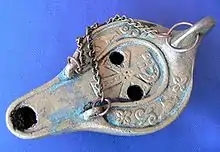
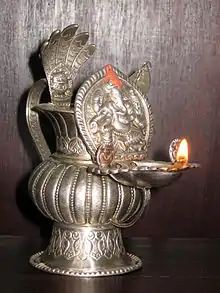


Oil lamps are a form of lighting, and were used as an alternative to candles before the use of electric lights. Starting in 1780, the Argand lamp quickly replaced other oil lamps still in their basic ancient form. These in turn were replaced by the kerosene lamp in about 1850. In small towns and rural areas the latter continued in use well into the 20th century, until such areas were finally electrified and light bulbs could be used.
Sources of fuel for oil lamps include a wide variety of plants such as nuts (walnuts, almonds, and kukui) and seeds (sesame, olive, castor, or flax). Also widely used were animal fats (butter, ghee, fish oil, shark liver, whale blubber, or seal). Camphine, a blend of turpentine and ethanol, was the first "burning fluid" fuel for lamps after whale oil supplies were depleted. It was replaced by kerosene after the US Congress enacted excise taxes on alcohol to pay for the Civil War.
Most modern lamps (such as fueled lanterns) have been replaced by gas-based or petroleum-based fuels to operate when emergency non-electric light is required. Therefore, oil lamps of today are primarily used for the particular ambience they produce.
Components
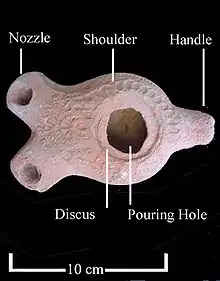
The following are the main external parts of a terra-cotta lamp:
- Shoulder
- Pouring hole
- The hole through which fuel is put inside the fuel chamber. The width generally ranges from 0.5–5 cm (0.20–1.97 in) in general. There may be one hole or multiple holes.
- Wick hole and the nozzle
- May be either an opening in the body of the lamp or an elongated nozzle. In some specific types of lamps, there is a groove on the top of the nozzle that runs along to the pouring hole to re-collect the oozing oil from the wick.
- Handle
- Lamps can come with or without a handle. The handle can come in different shapes. The most common is a ring-shaped for the forefinger surmounted by a palmette, on which the thumb is pressed to stabilize the lamp. Other handles can be crescent-shaped, triangular, or oval-shaped. The handleless lamps usually have an elongated nozzle, and sometimes have a lug rising diagonally from the periphery. The lug may act as a small handle where the thumb rests. Some lugs are pierced. It was speculated that pierced lugs were used to place a pen or straw, called the Latin: acus or festuca, with which the wick was trimmed. Others think that the pierced lugs were used to hang the lamp on a metal hook when not in use.
- Discus
- Fuel chamber
- The fuel reservoir. The mean volume in a typical terra-cotta lamp is 20 cc (20 mL).
Lamp typology
Lamps can be categorized based on different criteria, including material (clay, silver, bronze, gold, stone, slip), shape, structure, design, and imagery (e.g. symbolic, religious, mythological, erotic, battles, hunting).
Lamp typological categories
Typologically, lamps of the Ancient Mediterranean can be divided into seven major categories:
- Wheel-made
- This category includes Greek and Egyptian lamps that date before the 3rd century BC. They are characterized by simplicity, with little or no decoration, a wide pour-hole, a lack of handles, and a pierced or unpierced lug. Pierced lugs occurred briefly between the 4th and 3rd century BC. Unpierced lugs continued until the 1st century BC.
- Volute, Early Imperial
- With spiral, scroll-like ornaments called volutes extending from their nozzles, these lamps were predominantly produced in Italy during the Early Roman period. They have a wide discus, a narrow shoulder, no handle, elaborate imagery and artistic finishing, and a wide range of patterns of decoration.
- High Imperial
- These lamps are late Roman. The shoulder is wider and the discus is smaller with fewer decorations. These lamps have handles, short, plain nozzles, and less artistic finishing.
- Frog
- This is a regional style lamp exclusively produced in Egypt and found in the regions around it, between c. 100 and 300 AD. The frog (Heqet) is an Egyptian fertility symbol.
- African Red Slip
- Lamps made in North Africa, but widely exported, decorated in a red slip. They date from the 2nd to the 7th century AD and comprise a wide variety of shapes including a flat, heavily decorated shoulder with a small and relatively shallow discus. Their decoration is either non-religious, Christian or Jewish. Grooves run from the nozzle back to the pouring hole. It is hypothesized that this is to take back spilled oil. These lamps often have more than one pour-hole.
- Slipper
- These lamps are oval-shaped and found mainly in the Levant. They were produced between the 3rd to 9th centuries AD. Decorations include vine scrolls, palm wreaths, and Greek letters.
- Factory lamps
- Also called German: Firmalampen, these are universal in distribution and simple in appearance. They have a channeled nozzle, plain discus, and two or three bumps on the shoulder. Initially made in factories in Northern Italy and Southern Gaul between the 1st and 3rd centuries AD, they were exported to all Roman provinces. The vast majority were stamped on the bottom to identify the manufacturer.
Oil lamps in religious contexts
Judaism
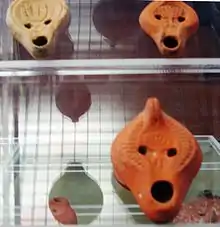
Lamps appear in the Torah and other Jewish sources as a symbol of "lighting" the way for the righteous, the wise, and for love and other positive values. While fire was often described as being destructive, light was given a positive spiritual meaning. The oil lamp and its light were important household items, and this may explain their symbolism. Oil lamps were used for many spiritual rituals. The oil lamp and its light also became important ritualistic articles with the further development of Jewish culture and religion. The Temple Menorah, a ritual seven-branched oil lamp used in the Second Temple, forms the centre of the Chanukah story.
Christianity
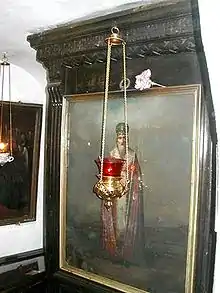
There are several references to oil lamps in the New Testament, In the Orthodox Church and many Eastern Catholic Churches oil lamps (Greek: kandili, Slavonic: Church Slavonic: lampada) are still used both on the Holy Table (altar) and to illuminate icons on the iconostasis and around the temple (church building). Orthodox Christians will also use oil lamps in their homes to illuminate their icon corner. Traditionally, the sanctuary lamp in an Orthodox church is an oil lamp. It is lit by the bishop when the church is consecrated, and ideally it should burn perpetually thereafter. The oil burned in all of these lamps is traditionally olive oil. Oil lamps are also referenced as a symbol throughout the New Testament, including in the Parable of the Ten Virgins.
Hinduism

Oil lamps are commonly used in Hindu temples as well as in home shrines. Generally the lamps used in temples are circular with places for five wicks. They are made of metal and either suspended on a chain or screwed onto a pedestal. There will usually be at least one lamp in each shrine, and the main shrine may contain several. Usually only one wick is lit, with all five burning only on festive occasions. The oil lamp is used in the Hindu ritual of Aarti.
In the home shrine, the style of lamp is usually different, containing only one wick. There is usually a piece of metal that forms the back of the lamp, which has a picture of a Hindu deity embossed on it. In many houses, the lamp burns all day, but in other homes, it is lit at sundown. The lamp in the home shrine is supposed to be lit before any other lights are turned on at night.
A hand-held oil lamp or incense sticks (lit from the lamp) are also used during the Hindu puja ceremony. In the North of India, a five-wick lamp is used, usually fueled with ghee. On special occasions, various other lamps may be used for puja, the most elaborate having several tiers of wicks.
In South India, there are a few types of oil lamps that are common in temples and traditional rituals. Some of the smaller ones are used for offerings as well.
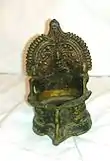
- Deepalakshmi
- A brass lamp with a depiction of goddess Sri Lakshmi over the back piece. They are usually small and have only one wick.
- Nilavilakku
- A tall brass or bronze lamp on a stand where the wicks are placed at a certain height.
- Paavai vilakku
- A brass or bronze lamp in the form of a lady holding a vessel with her hands. This type of lamp comes in different sizes, from very small to almost life-size. There are also large stone versions of this lamp in Hindu temples and shrines of Karnataka, Tamil Nadu and Kerala, especially at the base of columns and flanking the entrance of temples. They have only one wick.
- Thooku vilakku
- A brass or bronze lamp hanging from a chain, often with multiple wicks.
- Nachiarkoil lamp
- An ornamental brass lamp made of series of diyas, a handicraft product which is exclusively made by the Pather (Kammalar) community in Nachiyar Koil, Tamil Nadu, India.[1]
Chinese folk religion

Oil lamps are lit at traditional Chinese shrines before either an image of a deity or a plaque with Classical Chinese characters giving the name of the deity. Such lamps are usually made from clear glass (giving them a similar appearance to normal drinking glasses) and are filled with oil, sometimes with water underneath. A cork or plastic floater containing a wick is placed on top of the oil with the bottom of the wick submerged in the oil.
Such lamps are kept burning in shrines, whether private or public, and incense sticks or joss sticks are lit from the lamp.
History
Curved stone lamps were found in places dated to the 10th millennium BC (Mesolithic, Middle Stone Age Period, c. 10,300–8000 BC). The oldest stone-oil lamp was found in Lascaux in 1940 in a cave that was inhabited 10,000 to 15,000 years ago.[2][3]
Some archaeologists claim that the first shell-lamps existed more than 6,000 years ago (Neolithic, Later Stone Age, c. 8500–4500 BC). They believe that the alabaster shell-shaped lamps dug up in Sumerian sites dating to 2600 BC were imitations of real shell-lamps that had been used for a long time (Early Bronze Age, Canaanite/Bronze I–IV, c. 3300–2000 BC).
It is generally agreed that the evolution of handmade lamps moved from bowl-shaped to saucer-shaped, then from saucer with a nozzle, to a closed bowl with a spout.
Chalcolithic Age, c. 4500–3300 BC
The first manufactured red pottery oil lamps appeared in the Chalcolithic. These were of the round bowl type.
The Bronze Ages (3200–1200 BC)
Bronze Age lamps were simple wheel-made bowls with a slight pinch on four sides for the wick. Later lamps had only one pinch. These lamps vary in the shape of the rim, the general shape of the bowl and the shape of the base.
- Intermediate Bronze Age lamps (EBIV/MBI)
- The earliest lamps known from Intermediate Bronze Age lamps (EBIV/MBI) With the four wick lamps. Lamps are made from large bowls with four shallow pinches for wicks, although some lamps with only a single pinch have also been found.[4]
- Middle Bronze Age lamps (MB)
- The four-wick oil lamps persist into this period. However, most lamps now have only one wick. Early in this period the pinch is shallow, while later on it becomes more prominent and the mouth protrudes from the lamp's body. The bases are simple and flat. The crude potter's wheel is introduced, transforming the handmade bowls to a more uniform container. The saucer style evolves into a single spout shape.
- Late Bronze Age lamps (LB)
- A more pronounced, deeper single spout is developed, and it is almost closed on the sides. The shape is evolving to be more triangular, deeper and larger. All lamps are now wheel-made, with simple and usually flat bases.
The Iron Age (1200–560 BC)
During the Iron Age, lamp rims become wider and flatter, with a deeper and higher spout. The tip of the spout is more upright in contrast to the rest of the rim.[5] The lamps are becoming variable in shape and distribution, although some remain similar to lamps from the Late Bronze period. In addition, other forms evolve, such as small lamps with a flat base and larger lamps with a round base. The later form continues into the Iron Age II.
In the later Iron Age, variant forms appear. One common type is small, with a wide rim and a wide base. Another type is a small, shallow bowl with a thick and high discus base.
Arctic
_(14758775556).jpg.webp)
The qulliq (seal-oil lamp) provided warmth and light in the harsh Arctic environment where there was no wood and where the sparse population relied almost entirely on seal oil. This lamp was the most important article of furniture for the Inuit, Yupik and other Eskimo peoples.[6]
The lamps were made of stone and their sizes and shapes of lamps could be different, but mostly were elliptical or half-moon shaped. The wicks were mostly made of dried moss or cottongrass and were lit along the edge of the lamp. A slab of seal blubber could be left to melt over the lamp feeding it with more fat.[7]
Persian
Persian lamps were large, with thin sides and a deep pinch that flattens the mouth and makes it protrude outward.
Greek
Greek lamps are more closed to avoid spilling. They are smaller and more refined. Most are handle-less. Some are with a lug, which may be pierced or not pierced. The nozzle is elongated. The rim is folded over so it overlaps in order to make the nozzle, and is then pinched to make the wick hole.
They are round in shape and wheel-made.
Chinese
The earliest Chinese oil lamps are dated from the Warring States period (481–221 BC). The ancient Chinese created oil lamps with a refillable reservoir and a fibrous wick, giving the lamp a controlled flame. Lamps were constructed from jade, bronze, ceramic, wood, stone, and other materials. The largest oil lamp excavated so far is one discovered in a 4th-century tomb located in modern Pingshan, Hebei.[8][9]
Early Roman
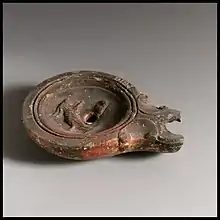
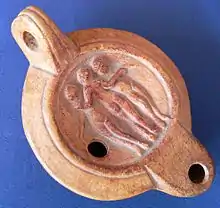
Production of oil lamps shifted to Italy as the main source of supply in the Early Roman era. Molds began to be used, and lamps were produced in large scale in factories. All lamps are closed in type. The lamp is produced in two parts, the upper part with the spout and the lower part with the fuel chamber. Most are of the characteristic "Imperial Type"—round, with nozzles of different forms (volute, semi-volute, U-shaped), a closed body, a central disk decorated with reliefs and a filling hole.
Late Roman
Late Roman lamps were of the "High Imperial" type. They included more decorations, and were produced locally or imported in large scale. The multiple-nozzled lamps appeared during this period. Many different varieties were created.
Frog type lamps also appeared during this period. These are kidney-shaped, heart-shaped or oval, and feature the motif of a frog or its abstraction, and sometimes geometrical motifs. They were produced around 100 AD. They are so variant that two identical lamps are seldom found.
Early Christian and Late Antique
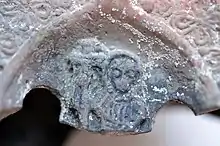
Early Christian and late antique oil lamps were diverse. One of the most notable ones were Mediterranean sigillata (“African”) lamps. The motifs were largely geometric, vegetative and graphic (monograms), with figural depiction of animals and human figures, often Christ.[10]
Byzantine
Oil lanterns of the Byzantine were slipper-shaped and highly decorative. The multiple-nozzle design continued and most lamps bore handles. Some have complex exteriors.
Early Islamic
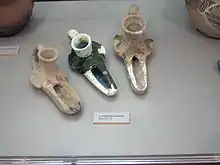
There is a transition period from Byzantine to Islamic lamps. The decoration on lamps of this transition period changed from crosses, animals, human likenesses, birds, or fish to plain linear, geometric, and raised-dot patterns.
The early Islamic lamps continued the traditions of Byzantine lamps. Decorations were initially a stylized form of a bird, grain, tree, plant, or flower. Later, they became entirely geometric or linear with raised dots.
In 9th-century Baghdad, al-Razi (Rhazes) described the first kerosene lamp; he referred to it as the Arabic: naffatah in his Kitab al-Asrar ('Book of Secrets').[11]
In the transition period, some lamps had Arabic writing. Writing later disappears until the Mamluk period (13th to 15th century AD).
Industrial age
Oil-burning carriage lamps provided a model for the first bicycle lamps in the 1860s.[12]
Regional variations
Israel and Palestinian territories
- Jerusalem oil lamp: The clay has a characteristic black color because it was burned without oxygen. Usually of high quality.
- Daroma oil lamp
- Jerash oil lamp
- Nabatean oil lamp
- Herodian oil lamp: Considered to be used mainly by Jews. Wheel-made, rounded, and have a nozzle with concave sides. The lamps are usually not decorated; if there is decoration, it tends to be simple. Very common throughout all of Palestine, and some lamps have also been found in Jordan. Date from the 1st century BC to the end of the 1st century AD.
- Menorah oil lamp, seven nozzles: Rare and are associated with Judaism because of the numerical connection with the seven branches or arms of the Menorah.
- Samaritan oil lamp: Characterized by a sealed filling hole, which was to be broken by the buyer. This was probably done to ensure ritual purity. They have a wider spout, and the concavities flanking the nozzle are almost always emphasized with a ladder pattern band. In general, the lamps are uncoated. The decorations are linear or geometric.
- Type I: A distinct channel runs from the pouring hole to the nozzle. They have a small knob handle, a ladder pattern around the nozzle and no ornamentation on the bottom of the base.
- Type II: Pear-shaped and elongated, with a lined channel that extends from the filling hole to the nozzle. Continued to be used up to the early Muslim period.
- Candle Stick oil lamp: Menorah design on the nozzle and bunch of grapes on the shoulders.
- Byzantine oil lamp: The upper parts and their handles are covered with braided patterns. All are made of a dark orange-red clay. A rounded bottom with a distinct X or cross appears inside the circled base.
- Early Islamic oil lamp: Large knob handle and the channel above the nozzle are the dominant elements of these. The handle is tongue-shaped, and decoration is rich and elegant. The lower parts are extremely broad and the nozzles are pointed.
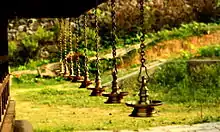
Importance of oil lamps in India
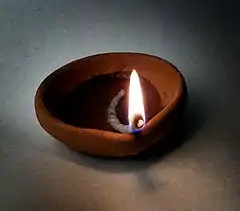

In Vedic times, fire was kept alive in every household in some form and carried with oneself while migrating to new locations. Later, the presence of fire in the household or a religious building was ensured by an oil lamp. Over the years various rituals and customs were woven around an oil lamp.
For Deep Daan, the gift of a lamp was and still is believed to be the best daan ('donation'). During marriages, spinsters of the household stand behind the bride and groom, holding an oil lamp to ward off evil. The presence of an oil lamp is an important aspect of ritual worship (the Shodashopachar Puja) offered to a deity. Moreover, a day is kept aside for the worship of the lamp in the busy festival calendar, on one amavasya (moonless) day in the month of Shravan. This reverence for the deep is based on the symbolism of the journey from darkness and ignorance to light and the knowledge of the ultimate reality – "tamaso ma jyotirgamaya".
Earlier lamps were made out of stone or seashells. The shape was like a circular bowl with a protruding beak. Later, they were replaced by earthen and metal lamps. In the epics Ramayana and Mahabharata, there are references to gold and silver lamps as well. The simple shape evolved and the lamps were created in the shapes of the matsya ('fish'), kurma ('tortoise') and other incarnations of god Vishnu. Lamps were also created in the shape of the many emblems of gods, like conch shells or lotuses. Birds such as swans, peacocks, or parrots, and animals like snakes, lions, elephants and horses were also favorites when decorating a lamp. For lighting multiple lamps, wooden and stone deepastambhas ('towers of light') were created.
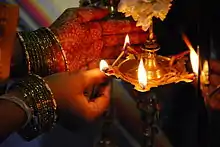
Erecting a deepastambha in front of a temple is still a general practice in western and southern India. In some of the South Indian temples, raised brass lamp towers called Kamba Vilakku can be seen. To adapt the design to households and smaller spaces, the deepavriksha ('tree of light') was created. As the name suggests, it is a metal lamp container with curvi-linear lines branching out from the base, each holding a lamp. The Deepalakshmi is another common design, where the goddess Lakshmi holds the lamp in her hands. Kuthuvilakku is another typical lamp traditionally used for household purposes in South India.
Oil lamps also were included in proverbs. For example, a Bradj (pre-Hindi) proverb says, "Chiraag tale andhera", 'the [utmost] darkness is under the oil-lamp (chiraag)', meaning that what you seek could be close but unnoticed (right under your nose or feet), in various senses (a lamp's container casts a strong shadow).
Oil tax
When the Big Temple in Thanjavur, Tamil Nadu, was built 1010 AD, there were elaborate measures taken to provide lighting for the temple. Lands were donated to or conquered for the temple for this sole objective. The income from these lands would go towards providing the oil for the lights.[13]
Books and catalogues
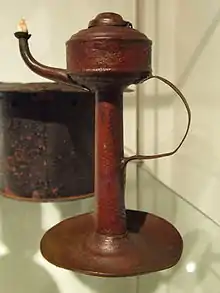
General
- Bailey, D. M. (1972). Greek and Roman Pottery Lamps. British Museum. ISBN 0-7141-1237-2. Excellent introductory booklet, well illustrated.
- Bailey, D. M. (1975–1996). A Catalogue of Lamps in the British Museum. British Museum. ISBN 0-7141-2206-8.
- Clephan, R. Coltman (1907). On Terra-cotta Lamps. Edinburgh. Edwardian illustrated article for the Society of Antiquaries of Scotland, interesting insight into the general knowledge of that time.
- Djuric, Srdjan (1995). The Anawati Collection Catalog I - Ancient Lamps from the Mediterranean. Eika. ISBN 1-896463-02-9. Less academic than the museum catalogues and short on dating but fairly comprehensive (within its specified area, i.e. not Northern Europe) and extensively illustrated.
- Hayes, J. W. (1980). Ancient Lamps in the Royal Ontario Museum - I: Greek and Roman Clay Lamps. ROM. ISBN 0-88854-253-4. Another superb catalogue and excellent reference, perhaps second only to Bailey.
- Lyon-Caen; Hoff (1986). Catalogue des Lampes en terre cuite Grecques et Chretiennes (in French). Louvre. ISBN 2-7118-2014-9. In French, good coverage of earlier and later lamps in the Louvre, well illustrated.
- Mlasowsky, Alexander (1993). Die antiken Tonlampen im Kestner-Museum Hannover (in German). Kestner-Museum. ISBN 3-924029-13-X. In German, superb catalogue, profusely illustrated and captioned.
- Robins, F. W. (1970). The Story of the Lamp. Kingsmead. ISBN 0-901571-33-4. (Reprint of 1939 edition.) Useful introduction but illustrations are very poor. Several of the items shown have since been exposed as fakes.
- Skinkel-Taupin, Claire (1980). Lampes en Terre Cuite de la Méditerranée Grecque et Romaine (in French). Brussels. In French, brief guide to a few lamps in the Brussels Museum.
- Walters, H. B. (1914). Catalogue of the Greek and Roman Lamps in the British Museum. British Museum. Superseded by Bailey but still worthwhile and much cheaper for an old copy.
- Wetzel, Henning (1997). Antike Tonlampen (in German). Leipzig University. ISBN 3-931922-65-0. In German, small booklet but excellent illustrations in color.
Western Europe
- Chrzanovski, Laurent (2000). Lumieres Antiques: Les lampes à huile du musée romain de Nyon (in French, English, Italian, and German). Edizioni ET. ISBN 88-86752-15-6. Paperback. In French, with short summaries in English, Italian and German. Excellent general survey of lamps, detailed study and catalogue of the small collection of Roman oil lamps at Nyon.
- Eckardt, Hella (2002). Illuminating Roman Britain. Montagnac: Editions Monique Mergoil. ISBN 2-907303-70-8. Paperback, frustratingly unindexed but a refreshing approach and well worth plowing through.
- Goethert, Karin (1997). Römische Lampen und Leuchter (in German). Trier: Auswahlkatalog des Rheinischen Landesmuseums Trier. ISBN 3-923319-38-X. In German, emphasis on local lamps found in Trier but excellent coverage of all Roman types of the Rhineland.
- Kirsch, Annette (2002). Antike Lampen im Landesmuseum Mainz (in German). Mainz. ISBN 3-8053-2864-8. In German, catalogue of lamps.
- Loeschcke, Siegfried (1919). Lampen aus Vindonissa (in German). Zurich. In German, long out-of-print classic but a superb reference.
Middle (Near) East
- Adler, Noam (2004). A comprehensive catalog of oil lamps of the Holy Land from the Adler collection. Israel: Old City Press. ISBN 965-555-166-0. Comprehensive coverage of lamps from the Palestine region.
- Rosenthal, Renate; Sivan, Renée (1978). Qedem 8, Monographs of the Institute of Archaeology, Vol. 8: Ancient Lamps in the Schloessinger Collection. The Hebrew University of Jerusalem. Standard reference.
Aegean
- Broneer, Oscar (1977). Isthmia Volume III: Terracotta Lamps. American School at Athens. Good coverage of local lamps.
- Perlzweig, Judith (1963). Lamps from the Athenian Agora. American School at Athens. Excellent booklet, profusely illustrated and a recommended reference, very cheap used copies.
North Africa
- Fabbricotti, E. (2001). Catalogo delle lucerne di Tolemaide (Cirenaica), BAR International Series 962 (in Italian). Oxford. ISBN 1-84171-182-9. In Italian, detailed catalogue of locally found lamps.
- Herrman, J. L.; van der Hoek, Annewies (2002). Light from the Age of Augustine. Harvard. Paperback, lavishly color-illustrated guide to North African red slipware including many lamps.
See also
- Ancient Roman oil lamp
- Kerosene lamp
- Lantern
- Lewis lamp
- List of light sources
- Timeline of lighting technology
- Diya (lamp)
References
- "PM Narendra Modi gifts Xi Jinping Annam lamp and Thanjavur painting". Times of India. 11 October 2019.
- Papatzanakis, Noufris (2012). "Ancient Oil Lamps History". Epalladio Art Workshop.
- "Parietal art: Lighting". Lascaux. Musée d'Archéologie nationale. Archived from the original on 2020-08-07. Retrieved 2020-08-07.
- Herriott, Conn (January 2015). Ilan, David; Shapira, Hananel; Feinberg-Vamosh, Miriam (eds.). "Artifacts from the Intermediate Bronze Age Tombs" (PDF). NGSBA Archaeology. Hebrew Union College. 3: 112–120.
- Biran, A.; Gopna, R. (1970). "An Iron Age Burial Cave at Tel Ḥalif". Israel Exploration Journal. Israel Exploration Society. 20 (3): 156–169. JSTOR 27925230.
- Joyce, Thomas Athol; Dalton, Ormonde Maddock (1910). "The Eskimo". Handbook to the ethnographical collections. Oxford: Oxford University Press. p. 249 – via Internet Archive.
- Brox, Jane (2010-06-29). "New Century, Last Flame". Brilliant: The Evolution of Artificial Light. Houghton Mifflin Harcourt. ISBN 978-0547487151. Archived from the original on 2020-01-25 – via ralphmag.org.
- China: Dawn of a Golden Age, 200-750 AD. Metropolitan Museum of Art. 2004. pp. 182–183. ISBN 978-1-58839-126-1.
- Handler, Sarah (2001). Austere Luminosity of Chinese Classical Furniture. University of California Press (published October 1, 2001). pp. 308–309. ISBN 978-0520214842.
- Jukić Buča, Vendi (2016). "Lamps from the upper layers of a site in Pula's St Theodore's quarter". Histria archaeologica : časopis Arheološkog muzeja Istre. 46/2015: 169–194.
- Bilkadi, Zayn (January 1995). "The Oil Weapons". Saudi Aramco World. Vol. 46 no. 1. Illustrated by Bob Lapsley. pp. 20–27.
- Clemitson, Suze (2017). A History of Cycling in 100 Objects. London: Bloomsbury Publishing. p. 114. ISBN 9781472918901. Retrieved 2018-04-22.
The first bicycle lamps from the 1860s were based on oil-burning carriage lanterns.
- Vasudevan, Geeta (2003). The Royal Temple of Rajaraja: An Instrument of Imperial Cola Power. Abhinav Publications. ISBN 8170173833.
Further reading
- Amiran, Ruth (1969). Ancient Pottery of the Holy Land: From Its Beginnings in the Neolithic Period to the End of the Iron Age. Jerusalem: Massada Press. ISBN 0813506344.
- Sussman, Varda (1983). "The Samaritan Oil Lamps from Apollonia-Arsuf". Tel Aviv. 10 (1): 71–96. doi:10.1179/tav.1983.1983.1.71.
- Wexler, Lior; Gilboa, Gabi (1996). "Oil Lamps of the Roman Period from Apollonia-Arsuf". Tel Aviv. 23 (1): 115–131. doi:10.1179/tav.1996.1996.1.115.
- Bailey, D. M. (1988). A Catalogue of the Lamps in the British Museum, III: Roman Provincial Lamps. Illustrated by S. Bird, Appendix by M. J. Hughes. London: British Museum Publications. ISBN 071411278X.
- Potok, Chaim (1978). Wanderings: Chaim Potok's History of the Jews. Alfred A. Knopf. ISBN 0394501101.
- Ran, Nachman (1987). Tracks to the Promised Land; The Land of Israel Ancient Maps, Prints and Travelogues Through the Centuries. Tel Aviv, Israel: Terra Sancta Arts. ISBN 9652600113.
- Rattey, B. K. (1964). A Short History of the Hebrews. Oxford University Press.
- Roth, C. (1996). Encyclopaedia Judaica. Keter Publishing.
- Runes, Dagobert D. (1959). Dictionary of Judaism. Kensington Publishing Corporation. ISBN 080650787X.
- Ryan, William; Pitman, Walter (2000). Noah's Flood. Simon and Schuster. ISBN 9780684859200.
- Scheindlin, Raymond P. (1996). The Chronicles of the Jewish People. Jonathan David Publishers. ISBN 0824603923.
- Stefoff, Rebecca (1997). Finding the Lost Cities. Oxford University Press. ISBN 019509249X.
- Sussman, Varda (1982). Ornamented Jewish Oil-lamps: From the Destruction of the Second Temple Through the Bar-Kokhba Revolt. Aris & Phillips. ISBN 0856681644.
- Encyclopaedia (CD-ROM). Grolier. 1994.
- TANAKH: The Holy Scriptures. Translated by Jewish Publication Society. 1985. ISBN 978-0-8276-0366-0.
- Uris, Leon; Uris, Jill (1984). Jerusalem: Song of Songs. Jerusalem: Doubleday and Company. ISBN 0385148631.
- von Soden, Wolfram (1994). The Ancient Orient: An Introduction to the Study of the Ancient Near East. Translated by Schley, Donald G. William B. Eerdmans Publishing Company. ISBN 0802801420.
External links
![]() Media related to Oil lamps at Wikimedia Commons
Media related to Oil lamps at Wikimedia Commons
- RomQ.com, Ancient Lamps
- Steve-Adler.com, Oil Lamps from the Holy Land, from the Adler collection Oil Lamps of Antiquity
- Murray, Alexander Stuart (1911). . Encyclopædia Britannica. 16 (11th ed.). (includes 5 diagrams)
